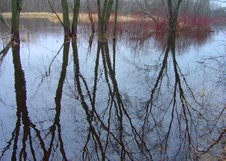
Photograph "Men displaying their catch" from the collection of Minnesota Historical Society (negative #64846)
The following exerpt is from an article titled "Without Careful Consideration: Why Carp Swim in Minnesota Waters" by Stephen R. Hoffbeck in the Summer 2001 (Volume 57, number 6, pages 305-320) issue of the
Minnesota History Quarterly about the man who introduced the carp to the Crow Wing River. It is certainly a cautionary tale about this dubious practice.
A typical Minnesota carp enthusiast was Wadena County's John Wesley Speelman. In the railroad town of Verndale, Speelman had a tree nursery that he had started upon his arrival from Nebraska in 1882. In that state he had sold trees to farmers who needed to plant them on their "tree claims." (Under provisions of the Homestead Act, claimants who planted 10 acres in trees could get a second 160 acre homestead.) In Minnesota, Speelman sold fruit trees-apple, crab apple, plum, and cherry—to help farmers diversify their farms. One variety he favored was the Russian mulberry tree, a foreign import that he thought could improve the fruit-growing prospects of Wadena County. If a Russian tree could grow in Minnesota, he reasoned, surely the German carp could also flourish in the waters near Verndale. This would diversify the fish populations of local rivers and lakes and help settlers reap a bounty of fish. A tinkerer by nature, Speelman also raised different breeds of chickens in order to find the fowl that could best adapt to local conditions. The logic of discovering the best fruit trees, chicken breeds, and fish stocks for Verndale was elementary to a man who worked closely with nature.
In the spring of 1884, Speelman explored local rivers, including the Shell and Crow Wing, to determine the feasibility of launching a steamboat enterprise. At the same time, he discovered places that seemed suitable for stocking German carp into the watershed, and he ordered his first shipment of twenty from the state.
In 1885 Speelman, described in the local newspaper as a "good and reliable" man, secured 40 more carp from the fisheries commission for further distribution around Verndale. His carp were a small part of a total of 3,105 stocked in the state that year. Two other varieties—mirror and leather—carp, also appeared in the commission's annual report of stocking activities.
 Board members Dave Mattila of Sebeka and Greg Leifermann of Motley planted a Wahoo tree at the Old Wadena Park site on Thursday, May 10. If you are wondering what a Wahoo tree is (I sure was), you can find information here and here. The tree was a gift to the Society from the Todd County Historical Society at the April annual meeting of the Society held at Wahoo Valley. Tom Kajer provided tools and black dirt, and the rest of us looked on approvingly.
Board members Dave Mattila of Sebeka and Greg Leifermann of Motley planted a Wahoo tree at the Old Wadena Park site on Thursday, May 10. If you are wondering what a Wahoo tree is (I sure was), you can find information here and here. The tree was a gift to the Society from the Todd County Historical Society at the April annual meeting of the Society held at Wahoo Valley. Tom Kajer provided tools and black dirt, and the rest of us looked on approvingly.



